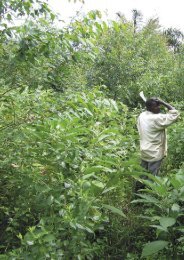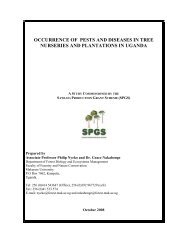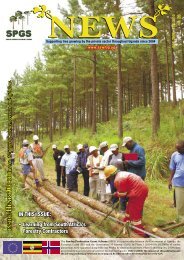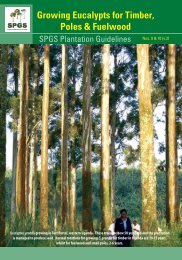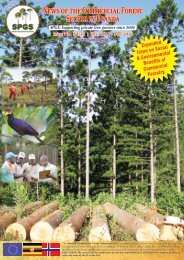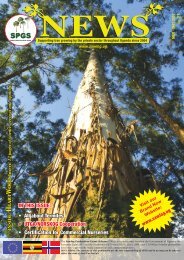COMMUNITY TREE PLANTING GUIDELINE - SPGS
COMMUNITY TREE PLANTING GUIDELINE - SPGS
COMMUNITY TREE PLANTING GUIDELINE - SPGS
Create successful ePaper yourself
Turn your PDF publications into a flip-book with our unique Google optimized e-Paper software.
LAWLOG PRODUCTION GRANT SCHEME<br />
Rwoho CFR (Ntungamo district) while aphids used to<br />
destroy Cypress trees but have since been biologically<br />
controlled just like pine woolly aphids. Isolated cases<br />
of Armillaria root rot disease attack on pines has been<br />
reported in Nabukonge CFR in Masaka and Global<br />
woods plantations in Kikonda CFR. Otherwise apart<br />
from the current Chalcid wasp on Eucalypts, there<br />
is no major threat from pests and diseases for the<br />
recommended trees as long as they are planted on right<br />
sites and well looked after. Please refer to section 6.2<br />
for what you can do to protect your plantation.<br />
in community<br />
planting) it allows Note: Number of seedlings in one hectare = area of a hectare ÷ spacing chosen<br />
for some food = 10,000m 2 ÷ 3x3=1111sph or 10,000m 2 ÷ 2.7 x 2.7 = 1,372 sph.<br />
crops to be planted<br />
between tree rows. Remember that when planting at<br />
Remember<br />
1,111 stems<br />
that<br />
per hectare<br />
when<br />
(sph)<br />
planting<br />
instead<br />
at 1,111<br />
of the<br />
stems<br />
more 1,372<br />
per<br />
sph, your costs on buying seedlings<br />
hectare<br />
and labour<br />
(sph) instead<br />
for pitting<br />
of the<br />
and<br />
more<br />
spot hoeing<br />
1,372 sph,<br />
can<br />
your<br />
be reduced<br />
costs<br />
by almost 20%.<br />
However, wider spacing between trees can have negative on buying seedlings and labour for pitting and spot<br />
effects like;<br />
hoeing can be reduced by almost 20%.<br />
3.5 Where do I get the seed/seedlings for planting?<br />
One of the determinants of your plantation success is the use of high quality tree seed or<br />
• It will take longer time seedlings. before trees Quality close here canopy-<br />
mainly refers to whether the seed is an improved variety (i.e. has<br />
superior growth & timber characteristics<br />
<br />
and good health). Community Tree Planting Guideline<br />
so you spend more money on weeding your trees.<br />
• Trees tend to develop thicker or bigger branches at<br />
the expense of the main stem<br />
• Trees will be fewer and so you will have less trees<br />
to choose from during thinning<br />
• Increased weed growth (as they are exposed to<br />
light) will most likely increase fire risk on your<br />
plantation<br />
• Total volume production is reduced and<br />
• You catch less early money which people usually<br />
get from thinnings.<br />
More information on selecting the right tree species can<br />
be found in <strong>SPGS</strong> Plantation Guideline Nos. 5 & 6<br />
3.4 What distance apart should<br />
I plant my trees?<br />
Having determined the right tree species for your area,<br />
it is now important that you get the right spacing to use<br />
on your area so that you order for the right number of<br />
seedlings. We strongly recommend planting your trees<br />
in lines, which makes everything easier later on – from<br />
preparing the planting pits to weeding after planting.<br />
The actual space (distance) between trees may change<br />
depending on type of tree species, quality of seed,<br />
expected growth rate, planned weeding technique<br />
and the availability of market for thinnings or small<br />
thinning).<br />
• There is less<br />
c o m p e t i t i o n<br />
between trees for a<br />
longer time<br />
• Cost savings (less<br />
pits and seedlings<br />
per hectare<br />
• Trees grow larger<br />
• Where it may<br />
be required (like<br />
The standard spacing however for most timber trees<br />
including pines and Eucalypts of improved seed and<br />
good quality seedlings is 3m x 3m (10ftx10ft). Also 2.7m<br />
x 2.7m (9ft x 9ft) is frequently used. But if planting next<br />
to where there is high demand for small construction<br />
poles the spacing for Eucalypts can be reduced up to<br />
2m x 2m (6.6ft x 6.6ft). However closer spacing like<br />
2m x 2m brings in an early competition between trees<br />
and so a farmer must be aware and be prepared to cut<br />
down many of them during first thinning operation to<br />
allow for better growth of the remaining trees. It is<br />
a must that all trees being grown for sawlogs/timber<br />
production will have to be thinned (refer to section 8<br />
on thinning).<br />
operation to allow for better growth of the remaining trees. It is a must that all trees<br />
being grown for sawlogs/timber production will have to be thinned (refer to section 8 on<br />
diameter poles. It may be beneficial to plant trees at<br />
a wider spacing such<br />
Table 3: Commonly used spacing and number of seedlings needed per hectare<br />
that;<br />
Tree common name Recommended No. of seedlings 15% for<br />
spacing meters (m) per hectare (sph) Beating up<br />
Total required<br />
Seedlings<br />
Eucalyptus 2x2 2,500 375 2,875<br />
2x3 2,000 300 2,300<br />
2.5x2.5 1,600 240 1,840<br />
3x3 1,111 167 1,278<br />
Pine 3x3 1,111 167 1,278<br />
Teak 3x3 1,111 157 1,278<br />
Araucaria 3x3 1,111 167 1,278<br />
Musizi<br />
4x4 625 94<br />
716<br />
Terminalia 4x4 625 94 716



